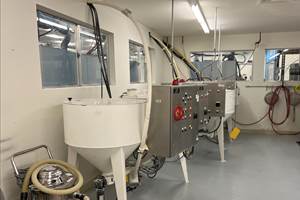Chiron’s High-Speed Additive Manufacturing Coating for Brake Discs
The process offers advantages over thermal coating with high-velocity flame spraying — the brake discs don’t need to be pretreated and the process is significantly faster.
Share
Read Next
Process advantage for a high coating speed: The powder particles already melt in the laser beam. Photo Credit: Chiron
Chiron Group’s additive manufacturing (AM) coating is an industrial system designed for 24/7 operation for applying extremely hard coatings to brake discs. The company says the protective layer is applied onto the brake disc faster and better, while also staying on longer.
“The solution is intelligent coatings, which we can apply with our AM Coating system,” says Dr. Geza Koscsak, head of AM at the Chiron Group. In his previous position as head of Chiron’s predevelopment, he was significantly involved in the development of the system and the decision in favor of the high-speed buildup welding process.
With high-speed laser metal deposition (LMD) welding, the powder particles cover a longer distance than with conventional LMD processes before they are deposited. In this way, they can absorb more energy and already melt in the laser beam, which enables a significantly faster coating speed. The process also has a clear advantage over thermal coating with high-velocity flame spraying: the brake discs do not need to be pretreated and the process is significantly shorter.
The higher speed and shorter process are two advantages that AM Coating offers. It will also have an added advantage in relation to the future Euro 7 standard. “When the standard comes — and it will definitely come — then a production volume of 10 million brake discs per year will have to be managed for the European vehicle brands alone,” Dr. Koscsák says. “With a cycle time of around 30 seconds per disc for classic brake discs, it is clear that the coating process has to keep up.”
The AM Coating is available in two versions: AM Coating Twin and Single. The AM Coating Twin is for series production. The system works with two lasers for the front and rear coating, with the fully automatic transfer of the brake discs. AM Coating Single is well suited for anyone who wants to test materials and material combinations in parallel with series production or, in advance, develop the application process or produce small series.
On request, the Chiron Group’s team of experts will provide support for process development, either at the customer’s site or in Tuttlingen. Chiron can install a machine on which the customer’s specialists can get to know the process, run tests and work with Chiron specialists to design the parameters ready for series production or for a consistent and even more productive process.
According to the company, the coating is durable and resists cracking. “Using high-speed laser deposition welding, we achieve improved adhesion through a material connection. In addition, the layer thickness is less, it is in the range of tenths of a millimeter,” says Ernest Frombach, Chiron project manager. “This means that much less material is used and, thanks to our powder management, we achieve a high degree of powder utilization. Buffer and hard material layers are applied directly one after the other. With the application of the first layer, the brake disc is tempered, so to speak. We consistently achieve the best application quality, brake disc for brake disc, without the formation of pores or cracks.”
- Listen to episode 27 of The Cool Parts Show to hear how additive manufacturing enables lighter, better-performing brake rotor production.
Related Content
Multimaterial 3D Printing Enables Solid State Batteries
By combining different 3D printing processes and materials in a single layer, Sakuu’s Kavian platform can produce batteries for electric vehicles and other applications with twice the energy density and greater safety than traditional lithium-ion solutions.
Read More3D Printed Cutting Tool for Large Transmission Part: The Cool Parts Show Bonus
A boring tool that was once 30 kg challenged the performance of the machining center using it. The replacement tool is 11.5 kg, and more efficient as well, thanks to generative design.
Read MoreWhat Does Additive Manufacturing Readiness Look Like?
The promise of distributed manufacturing is alluring, but to get there AM first needs to master scale production. GKN Additive’s Michigan facility illustrates what the journey might look like.
Read MoreA Tour of The Stratasys Direct Manufacturing Facility
The company's Belton manufacturing site in Texas is growing to support its various 3D printing applications for mass production in industries such as automotive and aerospace.
Read MoreRead Next
Hybrid Additive Manufacturing Machine Tools Continue to Make Gains (Includes Video)
The hybrid machine tool is an idea that continues to advance. Two important developments of recent years expand the possibilities for this platform.
Read MoreAt General Atomics, Do Unmanned Aerial Systems Reveal the Future of Aircraft Manufacturing?
The maker of the Predator and SkyGuardian remote aircraft can implement additive manufacturing more rapidly and widely than the makers of other types of planes. The role of 3D printing in current and future UAS components hints at how far AM can go to save cost and time in aircraft production and design.
Read More4 Ways the Education and Training Challenge Is Different for Additive Manufacturing
The advance of additive manufacturing means we need more professionals educated in AM technology.
Read More









.png;maxWidth=300;quality=90)














